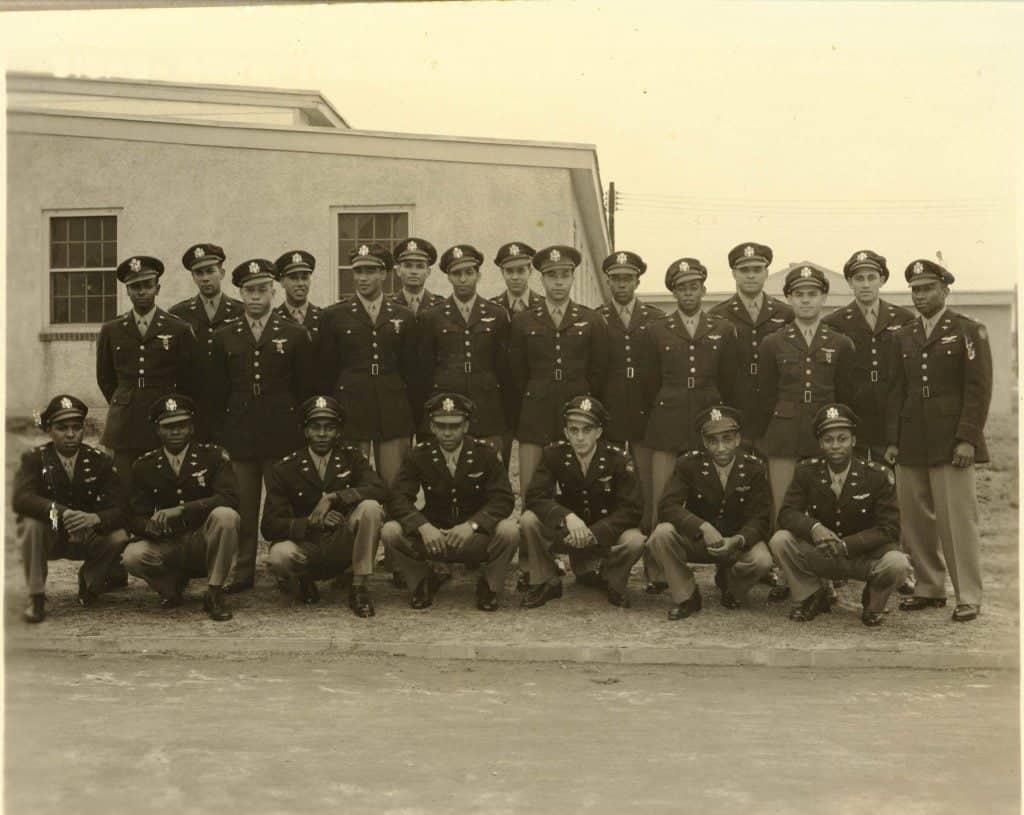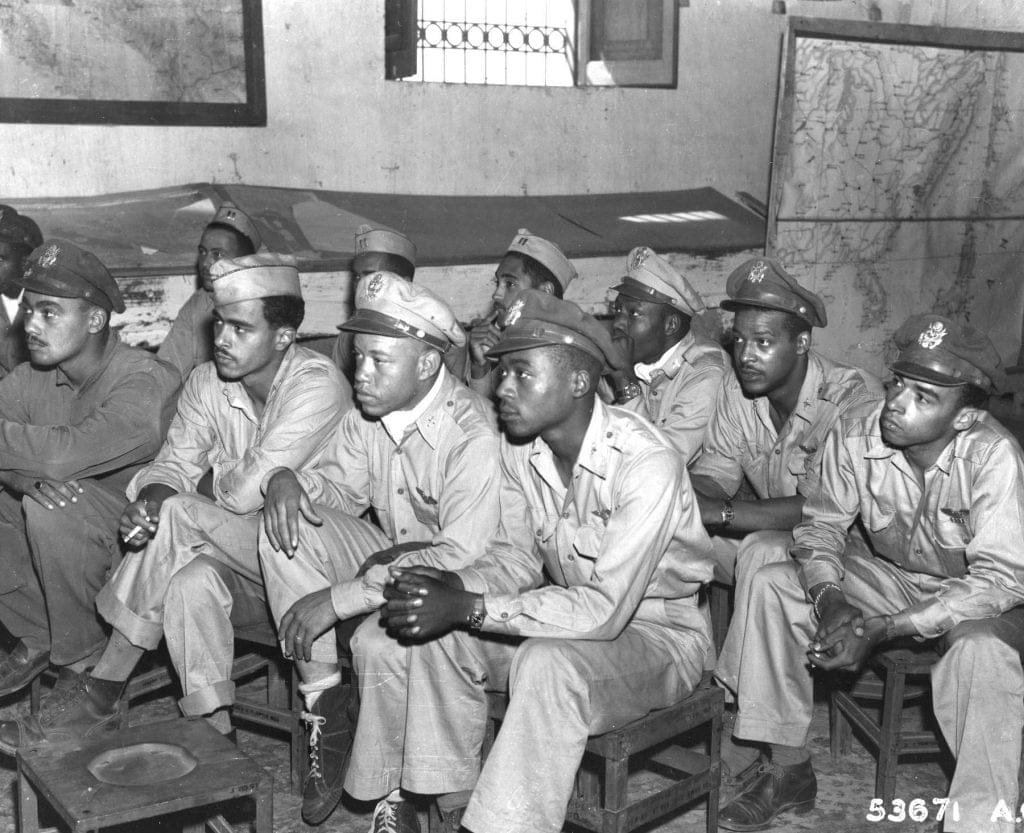 Clarence Nesbit Driver
Clarence Nesbit Driver
March 7, 1922 – March 7, 1973
Class: 44-A-SE
Unit: 302nd Fighter Squadron and 100th Fighter Squadron of the 332d Fighter Group
Clarence N. Driver aka “Red Driver” or “Bacon”, grew up and went to school in Los Angeles
After having graduated from TAAF Driver was assigned to the 126th AAF Base Unit (Fighter) Walterboro, Army Air Field, Walterboro, South Carolina where he flew the P-39, P-40, and P-47. He and his classmate were relieved from the 126th AAF BU on 22 May 1944 and ordered to Camp Patrick Henry, VA for subsequent movement to overseas destination for permanent change of station.
Upon reaching his destination, he was assigned to the 332nd Fighter Group, 302nd Fighter Squadron at Ramitelli, Italy as a replacement pilot on 20 June 1944. He remained with the 302nd FS until it’s deactivation in March 1945 after which he was transferred to the 100th FS until his loss and capture on 31 March 1945.
See his MACR in the Virtual Museum!
1st Lieutenant was one of three Tuskegee Airmen reported missing on a March 31, 1945 fighter sweep and strafing mission. Driver went missing at 1315 (1:15 pm) over northern Italy, possibly because of low fuel. The war was almost over, and Driver eventually returned to his unit. The information is on page 193 of the book THE TUSKEGEE AIRMEN: AN ILLUSTRATED HISTORY, which Dr. Daniel Haulman, PhD co-authored with Joseph Caver and Jerome Ennels.

SE/TE-44A. Red Driver is in the middle row, 2nd from the left. Photo courtesy The Craig Huntly Collection

Red Driver in Briefing Sept 1944. Photo courtesy Craig Huntly The Craig Huntly Collection
Driver’s service after WWII:
During the 1950’s, the deteriorating political situation in Laos allowed the North Vietnamese Army and Pathet Lao guerrillas to seize the Laotian panhandle from the Royal Lao Army. Even though the Geneva Accords restricted a large military presence in Laos, in 1958 the US established a “Program Evaluation Office” (PEO) as a CIA cover for anti-Communist covert operations.
Air America, the CIA’s covert airlines, supported the Hmong as well as other agency-backed clandestine troops. As the war escalated throughout Southeast Asia, the growing US military presence guaranteed that Air America could operate in relative obscurity. Likewise, with little fanfare throughout the war, Air America fought in the frontlines of the unconventional war with very little attention paid to it. Its aircrews flew “black missions” over China, North Vietnam and the Laotian panhandle and flew every type of aircraft from 727 jets to small Cessna’s transporting everything from combat troops (alive, wounded or dead) to baby chicks, while supplying refugees and specially trained Chinese Nung trailwatchers operating in areas denied to US military personnel, with whatever was needed.
On 7 March 1973, Clarence N. Driver, pilot, James H. Ackley, co-pilot, and two “kickers” – one Lao and one Thai – whose job it was to push the pallets of supplies out the back of the aircraft, comprised the civilian crew of C123K, tail # NBR-524, that departed Luang Prabang Airbase, Laos on a backlog cargo/rice resupply mission. The last radio contact with the aircrew was upon take-off en-route to Houei Sai, Xaignabouli Province, Laos.
A standard communication search was initiated at 1610 hours when their scheduled 30 minutes “ops normal” radio report was overdue, then search and rescue (SAR) aircraft began a flight route/area search at 1620 hours, but was hampered by numerous thunderstorms in the area. At the time the Provider departed its base, weather conditions consisted of broken clouds with bases at 3,000 feet, overcast cloud cover at 8,000 feet and 4-mile visibility. There was also ground fog/haze in the area with no wind. Conditions in their destination location consisted of broken clouds with bases at 2,000 feet, overcast cloud cover at 6,000 feet, 2 miles visibility with thunderstorms, haze and 8 knot winds.
By 13 March, when the full-scale SAR efforts were terminated, 10 aircraft had logged over 75 hours of flight time without finding a trace of the aircraft or its crew. On 14 March a limited SAR was conducted using two aircraft. During this mission wreckage of the Provider was sighted south of Pak Beng. One of the aircraft got close enough to the wreckage to confirm that it was the C123K, tail # NBR-524, before being driven off by enemy ground fire. However, during this brief examination of the crash site, the SAR personnel could not determine whether or not the crew was able to successfully bail out of it or not. Both Clarence Driver and James Ackley were immediately listed Missing in Action.
In late 1984, a number of first-hand live-sighting refugee reports from unrelated sources were received by the US government indicating that Clarence Driver was alive, in good health, and being held in a group of some 8 American prisoners in Laos. There was no indication if James Ackley was one of the other Americans in this prison compound.
Clarence Driver and James Ackley are among nearly 600 Americans who disappeared in Laos. Many of these men were known to be alive on the ground. The Laotians admitted holding “tens of tens” of American Prisoners of War, but these men were never negotiated for either by direct negotiation between our countries or through the Paris Peace Accords which ended the War in Vietnam since Laos was not a party to that agreement.
Since the end of the Vietnam War well over 21,000 reports of American prisoners, missing and otherwise unaccounted for have been received by our government. Many of these reports document LIVE America Prisoners of War remaining captive throughout Southeast Asia TODAY.
Civilian employees, like military personnel, were called upon to operate in many dangerous circumstances, and they were prepared to lay down their lives or be captured, if necessary, in order to carry out their work. It probably never occurred to them that they could be abandoned in the same manner as American military men by their country.
Learn more about the 32 captured Tuskegee Airmen POWs
Sources:
Craig Huntly, Tuskegee Airmen Subject Matter Expert
Daniel Haulman, PhD, retired USAF historian
Task Force Omega Inc





